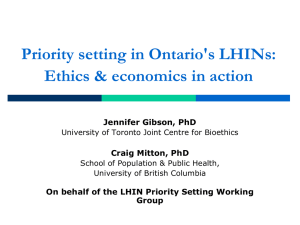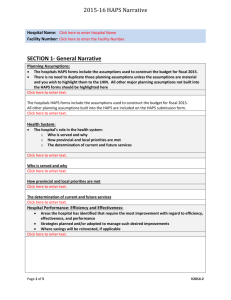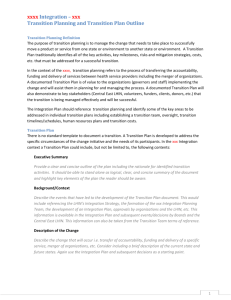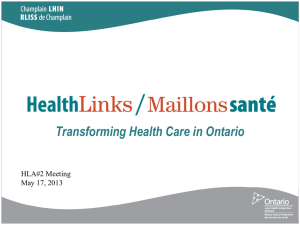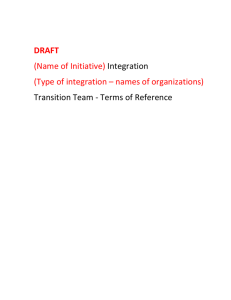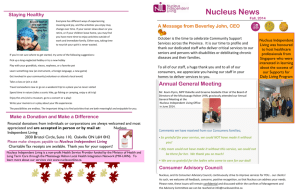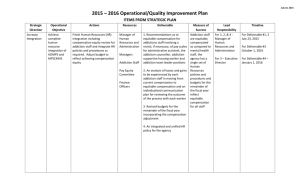HAPS Education Slide Deck
advertisement
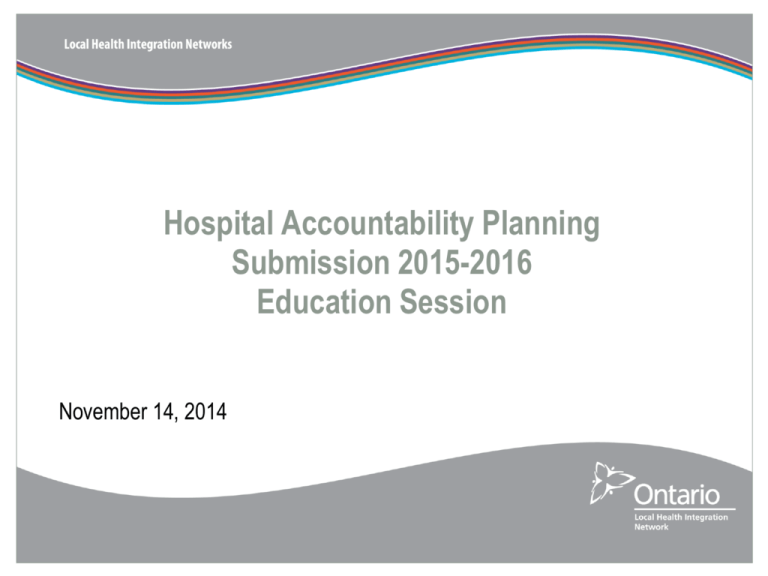
Hospital Accountability Planning Submission 2015-2016 Education Session November 14, 2014 Agenda 1. Context 2. HSAA Organizational Structure 3. Guiding Principles 4. HAPS Submission Timelines 5. Summary of Changes to Guidelines and Draft Schedules for 2015/16 6. Approach to Setting Planning Targets 2 Agenda (cont’d) 7. HAPS Report Submissions: Process Guidance for LHINs and Hospitals 8. HSAA Indicators 9. Overall Timelines 10. Questions 3 Context Planning for 2015/2016 • The HSAA Template Agreement is envisioned to be a multi-year agreement established through consultative stakeholder meetings between the LHINs, hospitals, the OHA and MOHLTC. The Schedules content will be negotiated annually. • Information collected through the Hospital Accountability Planning Submission (HAPS) and the supplemental report will be used to populate the HSAA Schedules. Both the HAPS forms and the guidelines have been refreshed. • The HAPS and related draft Schedules will cover one fiscal year (FY 2015/16). 4 Context Planning for 2015/2016 (cont’d) • The government continues to implement Health System Funding Reform (HSFR), which supports system capacity planning and quality improvement through directly linking funding to patient outcomes. LHINs and the hospitals recognize that HSFR will impact the HSAA process. • Hospital funding has become unique to each individual hospital with the roll out of the Health Based Allocation Model and Quality-Based Procedure Funding (QBP) and so “across the board” planning targets are no longer relevant or possible. 5 Context Planning for 2015/2016 (cont’d) • Hospitals are currently engaged in developing budgets to guide operations for fiscal 2015/16 as part of their organization’s fiduciary duty and hospital services will continue to be provided to patients according to the hospital’s internal plan and based on the hospital’s best assumptions. • There is great benefit for hospitals and LHINs to agree on performance expectations within a set of parameters that begins on day one of the fiscal year. The vehicle for this agreement is the HSAA. 6 HSAA Organizational Structure Creating an ownership framework Hospitals (OHA) LHINs HSAA Steering Committee Co-Chairs: Paul Huras, CEO SE LHIN Bill MacLeod, CEO MH LHIN Marian Walsh, CEO Bridgepoint HSAA Planning & Schedules Work Group HSAA Indicators Work Group Co-Chair: Sherry Kennedy, SE LHIN Co-Chair: May Chang, MSH Co-Chair: Mark Brintnell, SW LHIN Co-Chair: Imtiaz Daniel, OHA 7 HSAA Organizational Structure Creating an ownership framework (cont’d) • The HSAA Planning & Schedules Work Group is co-led by Sherry Kennedy, Chief Operating Officer of the South East LHIN, and May Chang, Executive Vice President, Strategy & Patient Experience, Markham Stouffville Hospital. • Based on the HSAA Steering Committee’s planning assumptions, the core deliverables of the HSAA Planning & Schedules Work Group were to prepare draft schedules and planning submission documents and produce related education materials. 8 HSAA P&S WG Guiding Principles Developing the HAPS materials • The deliverables of the Planning & Schedules Work Group were set with the following guiding principles in mind: 1. Practicality - Develop products that reflect our current reality and are easy to use/understand. 2. Emphasis on local within the provincial context - For planning targets, performance indicator targets and other health system changes. 3. Partnership Approach - Hospitals and LHINs should talk early and often in order to develop a mutually acceptable HSAA within the requisite timeline. 9 HSAA P&S WG Guiding Principles Developing the HAPS materials (cont’d) 4. Ensure alignment. All core HAPS/HSAA materials (Guidelines, Forms and Schedules), should align with one another. The Work Group will also strive for enhanced functionality whereby one form/schedule may be pre-populated by another where appropriate. 10 HAPS Submission Timelines Main differences between 2014/15 and 2015/16 • Last year the HAPS document was due in February 2014. Unfortunately, this did not leave enough time for the LHINs to complete their review and turn around the HSAAs for April 1. As a result, the HAPS completion timeline is earlier this year. • HAPS submission period will be from December 19, 2014 to January 16, 2015. LHINs will be in touch with individual hospitals to confirm each hospital’s specific submission date within that period. • Board approval is not required for HAPS submission. • LHINs will also provide information to hospitals as to their approach to analysis to ensure necessary information/explanation can be provided by hospitals at submission. 11 HAPS Guidelines Main differences between 2014/15 and 2015/16 • Incorporated new content regarding Provincial Interest Programs. • Provided greater clarity around the objectives of HBAM and QBPs. • Added description of new HAPS Narrative template. • Updated language regarding HSFR. 12 Draft HSAA Schedules: Schedule A - Funding Allocation Main differences between 2014/15 and 2015/16 • Updated to include all funding categories (HSFR and Non-HSFR) • Additions for non-HSFR funded categories include: • Recoveries and Miscellaneous Revenues • Amortization of Grants/Donations Equipment • OHIP Revenue and Patient Revenue from Other Payors • Differential and Copayment Revenue 13 Draft HSAA Schedules: Schedule A - Funding Allocation Main differences between 2014/15 and 2015/16 • Quality Based Procedures for 2015/16 have been added and activated within the Schedules: • Coronary artery disease • Aortic valve replacement • Cancer surgery • Colposcopy • Knee arthroscopy • Retinal disease • Short stay post-hospital discharge homecare: Medical discharge 14 Draft HSAA Schedules: Schedule B – Reporting Requirements Main differences between 2014/15 and 2015/16 • Updated reporting dates for the new term. MIS Trial Balance Due Date Q2 – April 01 to Sep 30, 2015 Q3 – Oct 01 to Dec 31, 2015 Q4 – Jan 01 to Mar 31, 2016 31-October-2015 31-January-2016 31-May-2016 Quarterly SRI and Supplemental Reporting Due Date Q2 – April 01 to Sep 30, 2015 Q3 – Oct 01 to Dec 31, 2015 Q4 – Jan 01 to Mar 31, 2016 Year End 2015-16 07-November-2015 07-February-2016 30-June-2016 30-June-2016 Audited Financial Statements (Fiscal Year) Due Date 2015-16 30-Jun-2016 French Language Services Report (Fiscal Year) Due Date 2015-16 30-Apr-2016 15 Draft HSAA Schedules: Schedule C1 Performance Indicators Main differences between 2014/15 and 2015/16 • Information on 2015/16 indicators will be communicated in the time ahead. 16 Draft HSAA Schedules: Schedule C2 - Service Volumes Main differences between 2014/15 and 2015/16 • Added new Quality Based Procedure volumes for 2015/16. • Updates have been made to the following and will be available within the technical specifications document: o o o o o o o o o o o AICD (Numbers of New Implants) Bariatric Surgery (Procedures) Cleft Palate (Cases) Cochlear Implants (Cases) General Surgery (Base and Incremental) Hip and Knee Replacement (Cases) MRI (Total Hours) OBSP MRI (Total Hours) Paediatric Surgery (Base and Incremental) Sexual Assault/Domestic Violence Treatment Clinics (Patients) CT (Total Hours) 17 Draft HSAA Schedules: Schedule C3 - LHIN Indicators and Volumes Main differences between 2014/15 and 2015/16 • Content will be negotiated locally. 18 Draft HSAA Schedules: Schedule C4 – PCOP Main differences between 2014/15 and 2015/16 • The PCOP Schedule is expected to be re-introduced but without the requirement for funding or volume detail. Instead, the Schedule is expected to confirm that PCOP funding and related performance requirements will be communicated in separate funding letters and are subject to the Terms and Conditions applicable to the overall HSAA. 19 Draft HSAA Schedules: Schedule D – Compliance Declaration Main differences between 2014/15 and 2015/16 • There is ongoing dialogue about the inclusion of this Schedule. 20 Approach to Setting Planning Targets Premise: There is great benefit for hospitals and LHINs to agree on performance expectations within a set of parameters that begins on day one of the agreement year. Development Principles: • Work in partnership • Reflect local reality within the provincial context • Build on existing/current hospital budget efforts • Manage mutual risk • Leverage continuous quality improvement processes 21 Approach to Setting Planning Targets (cont’d) • Actual funding allocations are not available until well into any fiscal year and so setting planning target assumptions are necessary to develop and populate HAPS and Schedules. The HSAA Steering Committee has confirmed that the following is a practical and reasonable approach to this reality: • Leveraging and aligning with internal hospital budget processes: Hospitals will locally determine their best estimates for planning assumptions for global, HBAM, QBP, etc. (including an assumption for mitigation where applicable) for use in completing the HAPS and related schedules for 2015/16 using their current knowledge. 22 Approach to Setting Planning Targets (cont’d) • Focus on reasonability: LHINs will review and discuss these assumptions with hospitals within their region and assess the proposed planning targets for reasonableness. • Mitigating the risk: In order to mitigate the risk to hospitals and LHINs that actual funding will be different than planning targets used to populate the Schedules of an HSAA, a materiality “trigger” will be incorporated in the HSAA template. 23 Approach to Setting Planning Targets (cont’d) • Materiality assessed on performance indicators and volume targets: Where the HSFR assumptions used in planning are different than actual funding allocations, and these result in the hospital being unable to deliver on a performance commitment, this will trigger a resubmission/renegotiation of the affected HSAA schedules. • Detailed language and process guidance to follow: Note that the HSAA Steering Committee has approved this approach and has requested the development of appropriate language for inclusion in the HSAA template as well as process guidance for the field. 24 HAPS Report Submissions: Process Guidance for LHINs and Hospitals 1. 2. 3. LHINs will review HAPS reference materials (HAPS Guidelines and User Guide) and post them to their websites. HAPS templates have been loaded onto SRI for hospitals to access. LHINs will organize meetings with their hospitals to: • Understand each hospitals’ planning target assumptions and to determine reasonableness of same • Communicate and discuss LHIN expectations with respect to volume and performance indicator targets (directional and/or specific as appropriate for the local context) • Communicate the local LHIN HAPS approach to analysis and review process 25 HAPS Report Submissions (cont’d) 4. Hospitals will upload completed forms (final version only) to SRI. 5. LHINs begin HAPS review and negotiation process. 26 Overall Timelines Completing the 2015/16 HAPS Projected Timelines October 6 2015/16 HAPS available on SRI November 14 2015/16 HAPS materials education session December 19 – January 16 Hospitals submit completed HAPS reflecting initial hospital/LHIN discussions February 13 LHIN analysis completed, final negotiations of indicator targets and population of schedules completed, final HSAA template and schedules sent to hospitals for board approval March 31 HSAAs signed. All Board-approved HSAAs are due to the LHINs *Note: Education on the final template agreement, including finalized schedules, will be forthcoming 27 HSAA Planning & Schedules Work Group Membership Sector LHIN Organization Individual, Title SE LHIN Sherry Kennedy, COO (Co-Chair) Hospital Markham Stouffville Hospital May Chang, Executive VP, Strategy & Patient Experience (Co-Chair) Hospital London Health Sciences Centre Deepak Sharma, Director Hospital Red Lake Margaret Cochenour Memorial Hospital Paul Chatelain, Former President and CEO Hospital St Michael’s Hospital Tomi Nieminen, Director Hospital Sunnybrook Hospital David Couch, Director MOHLTC Ministry of Health and Long-Term Care Maria van Dyk, Team Lead OHA Ontario Hospital Association Imtiaz Daniel, Senior Consultant LHIN CH LHIN Elizabeth Woodbury, Senior Accountability Specialist LHIN MH LHIN Andrew Wahab, Senior Lead of Funding and Allocation LHIN NE LHIN Marc Demers, Controller / Corporate Services Manager 28 HSAA Planning & Schedules Work Group Membership (cont’d) Sector Organization Individual, Title LHIN NW LHIN Kevin Holder, Senior Consultant LHIN SE LHIN Mike McClelland, Senior Financial Analyst LHIN SW LHIN Scott Chambers, Team Lead LHIN SW LHIN Betty Wang, Financial Analyst LHIN TC LHIN Chris Sulway, Senior Consultant LHIN MH LHIN Laura Salisbury, Executive Lead (Observer) St. Michael’s Hospital Danielle Jane, Project Manager (Observer) Hospital 29 HSAA Indicators Work Group Membership Sector Organization Individual, Title LHIN SW LHIN Mark Brintnell, Senior Director (Co-Chair) OHA Ontario Hospital Association Imtiaz Daniel, Senior Consultant (Co-Chair) Hospital Markham Stouffville Hospital May Chang, Executive VP, Finance and Operations Hospital Grey Bruce Health Services Martin Mazza, CFO Hospital Ontario Shores John Chen, VP Finance and Support Services Hospital MHA Nancy Maltby, COO Hospital SJHC Hamilton Jane Loncke, Director Hospital Cambridge Memorial Hospital Mike Prociw, VP, Finance & Corporate Services, CFO & CIO MOHLTC Ministry of Health and Long-Term Care Jillian Paul, Manager MOHLTC Ministry of Health and Long-Term Care Naomi Kasman, Senior Health Analyst MOHLTC Ministry of Health and Long-Term Care Thomas Custers, Manager 30 HSAA Indicators Work Group Membership (cont’d) Sector Organization Individual, Title MOHLTC Ministry of Health and Long-Term Care Domenic Della Ventura, Team Lead MOHLTC Ministry of Health and Long-Term Care Nam Bains, Manager HQO Health Quality Ontario Gail Dobell, Director LHIN NE LHIN Marc Demers, Controller / Corporate Services Manager LHIN Central LHIN Jennifer Chiarcossi, Sr. Business Analyst LHIN HNHB LHIN Ajay Bhardwaj, Advisor LHIN CE LHIN Marilee Suter, Senior Consultant LHIN TC LHIN Chris Sulway, Senior Consultant LHIN TC LHIN Ranjeeta Wadhwani, Analyst 31 Questions? 32 APPENDIX: HSAA Content – Schedules Schedule A B C1 C2 C3 C4 D Title Description Funding Allocation Reflects the hospital’s best assumptions with respect to planning targets for each relevant category of revenue Reporting Requirements Lists various reporting obligations and relevant timelines Performance Indicators Reflects recommendations of the Provincial Performance Indicator Committee, approved by the HSAA Steering Committee Service Volumes Similar to prior years. Language updated LHIN Indicators and Volumes Standard template for locally negotiated indicators and obligations PCOP Clarifies that PCOP funding is subject to the terms and conditions of the overall HSAA Compliance Declaration Ongoing dialogue about whether this will be included *Appendix regarding Conflict of Interest Policy is also expected to be included. 33
